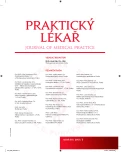Thymoma – a rare cause of pericardial effusion
Authors:
J. Chlumský 1; R. Lischke 2; A. Stolz 2; J. Zámečník 3; R. Mazanec 4
Authors‘ workplace:
2. LF UK, PrahaInterní klinika FN MotolPřednosta: prof. MUDr. Milan Kvapil, CSc., MBA
1; 1. LF UK, Praha3. chirurgická klinika FN MotolPřednosta: prof. MUDr. Robert Lischke, Ph. D.
2; 2. LF UK, PrahaÚstav patologie a molekulární medicíny FN MotolPřednosta: prof. MUDr. Roman Kodet, Dr. Sc.
3; 2. LF UK, PrahaNeurologická klinika FN MotolPřednosta: doc. MUDr. Petr Marusič, Ph. D.
4
Published in:
Prakt. Lék. 2013; 93(3): 125-128
Category:
Case Report
Overview
Pericardial effusion may accompany many diseases and its differential diagnosis is broad. The most common causes include acute pericarditis of different etiology, pericardial involvement in systemic diseases, myocardial infarction, malignant pericardial effusion and hypothyreosis. We report a case report of 56-year-old asymptomatic man with a large pericardial effusion and pathological mass in the anterior mediastinum on chest CT examinations with suspected thymoma. Transternal thymectomia and pericardial fenestration was performed, histological examination confirmed thymoma. Thymoma is known for its association with myasthenia gravis and paraneoplastic autoimmune disease, however half of the patients are asymptomatic. It is essential to distinguish thymoma from aggressive thymic carcinoma. Surgical resection is a basic curative procedure and radical removment of thymoma allows long-term survival.
Keywords:
pericardial effusion – thymoma – echocardiography
Sources
1. Colombo A. Etiology and prognostic implications of a large pericardial effusion in men. Clin Cardiol 1998; 11: 389–394.
2. Corey GR. Etiology of large pericardial effusions. Am J Med 1993; 95: 209–213.
3. Sagristà-Sauleda J, Mercé J, Permanyer-Miralda G, Soler-Soler J. Clinical clues to the causes of large pericardial effusion. Am J Med 2000; 109: 95–101.
4. Riedel RF, Burfeind WR. Thymoma: benign appearance, malignant potential. Oncologist 2006; 11: 887–894.
5. Tumors of the thymus. In: Travis W.D, Brambilla E, Müller-Hermelink H.K., Harris C.C. (Eds.). World Health Organization classification of tumors: pathology and genetics of tumors of the lung, pleura, thymus and heart. Lyon, France: International Agency for Research on Cancer (IARC) Press 2004; 145–247. Dostupné na: http://www.iarc.fr/en/publications/pdfs-online/pat-gen/bb10/bb10-chap3.pdf.
6. Engels EA, Pfeiffer RM. Malignant thymoma in the United States: demographic patterns in incidence and associations with subsequent malignancies. Int J Cancer 2003; 105: 546–551.
7. Thomas CR, Wright CD, Loehrer PJ, et al. Thymoma: state of the art. J Clin Oncol 1999; 17: 2280–2289.
8. Eng TY, Fuller CD, Jagirdar J, et al. Thymic carcinoma: state of the art review. Int J Radiat Oncol Biol Phys 2004; 59: 654–664.
9. Yuan PJ. Cardiac tamponade and thymic carcinoma. Acta Cardiol Sin 2006; 22: 1126–1129.
10. PDQ Cancer Information Summaries. Bethesda (MD): National Cancer Institute (US); 2002. Thymoma and Thymic Carcinoma Treatment (PDQ®): Health Professional Version. [Updated 2012 Sep 17]. Dostupné na: http://www.ncbi.nlm.nih.gov/books/NBK66041/.
11. Masaoka A, Monden Y, Nakahara K, et al. Follow-up study of thymomas with special reference to their clinical stages. Cancer 1981; 48: 2485–2492.
12. Budde JM, Morris CD, Gal AA, et al. Predictors of outcome in thymectomy for myasthenia gravis. Ann Thorac Surg 2001; 72: 197–202.
13. Evoli A, Minisci C, Di Schino C, et al. Thymoma in patients with MG: characteristics and long-term outcome. Neurology 2002; 59: 1844–1850.
14. Pan CC, Chen PC, Wang LS, et al. Thymoma is associated with an increased risk of second malignancy. Cancer 2001; 92: 2406–2411.
15. Moore KH, McKenzie PR, Kennedy CW, et al. Thymoma: trends over time. Ann Thorac Surg 2001; 72: 203–207.
Labels
General practitioner for children and adolescents General practitioner for adultsArticle was published in
General Practitioner

2013 Issue 3
Most read in this issue
- Thymoma – a rare cause of pericardial effusion
- Quality of sleep, circadian preference and healthy life style in university students
- Pitfalls of cancer screening in general practice
- The evaluation of assessment tools for needs identification in family members in palliative care
